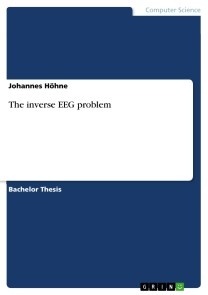The inverse EEG problem
29,99 €
inkl. 7% MwSt. und
ggf. zzgl. Versand
Bachelor Thesis from the year 2007 in the subject Computer Science - Miscellaneous, grade: 1.0, Free University of Berlin (Institute of Mathematics and Informatics, Department Bioinfomatics), language: English, abstract: Abstract: The inverse EEG problem is a well-studied, ill-posed problem in mathematics and neuroinformatics. Given a record of a limited number of electrodes (e.g. 21) that are placed on scalp, it is the task to estimate a three dimensional distribution of neural currents in the brain. The actual thesis deals with this problem and proposes a propabilistic Bayesian approach that assumes the distribution of neural currents to be heterogeneous - active and inactive regions in the brain are expected. This can be formalized with a mixture distribution. Furthermore, an expectation-maximization (EM) algorithm is presented that performs simultaneous classification and computation of neural currents, given an EEG measurement. Zusammenfassung: Diese Bachelorarbeit thematisiert das inverse EEG Problem. Dies ist ein umfangreich beschriebenes, schlecht gestelltes mathematisches Problem in der medizinischen Visualisierung. Bei einer EEG-Messung werden eine bestimmte Anzahl (z.B. 21) Elektroden an der Kopfhaut angebracht und elektrische Ströme dort detektiert. Das hier beschriebene Problem besteht darin, aus dieser Messung eine dreidimensionales Verteilung neuronaler Gehirnströme zu rekonstruieren. Es wird ein propabilistischer Bayesianischer Ansatz vorgestellt, um dieses Problem zu lösen. Dabei wird angenommen, dass die Verteilung neuronaler Ströme heterogen ist - es gibt aktive und nicht-aktive Bereiche im Gehirn. Dies wird mathematisch mit einer Mischverteilung formalisiert. Dieser Ansatz ermöglicht Gehirnströme sowohl zu berechnen, also auch zu klassifizieren. Ein entsprechender EM Algorithmus, der dies simultan durchführt, wird vorgestellt.

- Autor: Johannes Höhne
- Seitenzahl: 64
- Format: EPUB
- DRM: social-drm (ohne Kopierschutz)
- Erscheinungsdatum: 25.06.2008
- Herausgeber: GRIN VERLAG
